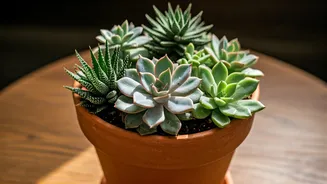Well-Draining Soil
The cornerstone of succulent health is the type of soil they inhabit. Succulents thrive in well-draining soil that prevents waterlogging, a common cause
of root rot. This unique soil blend should be porous, enabling water to drain quickly, whilst also ensuring that the roots receive sufficient oxygen to function optimally. Commercial cactus or succulent mixes, generally sold at most plant nurseries, are often ideal. Alternatively, you can create a DIY mixture by combining regular potting soil with components like coarse sand or perlite. The goal is to create a balance where water passes through efficiently, and the roots stay aerated, supporting the health and longevity of your succulents. The significance of good drainage helps prevent many issues and boosts the plant's vitality.
Water Sparingly
Succulents are adapted to arid environments; thus, overwatering is more detrimental than underwatering. The ideal watering technique involves allowing the soil to dry completely between watering sessions. The frequency of watering will hinge on various factors, including the environmental temperature and sunlight exposure. During the growing seasons, from spring through autumn, watering about once every two weeks is typically sufficient. When the weather cools down during the winter months, the watering frequency may need to be reduced to once per month, if at all. To determine if your succulent needs water, insert your finger into the soil; it should be dry to a depth of an inch or two before watering. This strategy helps mimic the natural conditions these plants are designed for, preventing rot and promoting robust growth.
Fertilize Sparingly
While essential nutrients are crucial for healthy plants, succulents benefit from a light fertilization routine. Frequent over-fertilizing can result in an accumulation of salts in the soil, leading to scorched roots and stunted growth. Instead, succulents should be fertilized during their growing season, which is usually spring and summer. Opt for a balanced, diluted liquid fertilizer specifically designed for succulents or cacti. Applying the fertilizer at half the strength advised on the product label ensures that your plants get the nutrients they need without suffering adverse effects. It is also possible to fertilize these plants about once or twice during their growing seasons. During the dormant winter period, hold off on fertilizing because the plant's metabolic rate is greatly reduced, and its need for nutrients is at a minimum.
Adequate Sunlight
Sunlight is crucial for the health and well-being of succulents, as it is essential for photosynthesis, the process that enables them to generate energy. The amount of sunlight required by these plants varies depending on the species, but in general, they thrive in bright, direct light. Succulents grown indoors should be positioned near a window that receives several hours of sunlight daily. A south-facing window is often the best choice, but east or west-facing windows can also work, depending on the intensity of the light. If your home lacks sufficient natural light, you can supplement it with grow lights, particularly during the darker winter months. The light must be consistent for optimal growth. If the succulents don't receive enough sunlight, they may stretch towards the light source, and this will cause them to become weak or elongated.
Monitor Temperature
Succulents can adapt to a range of temperatures, but their ideal conditions are warm and dry. Extreme temperature fluctuations can cause stress and damage. Most succulents grow best in temperatures between 18°C to 27°C (65°F to 80°F), which is the perfect indoor temperature for most homes. If kept outside, protect them from extreme heat or cold. In summer, provide shade during the hottest part of the day to prevent leaf burn. In winter, protect them from freezing temperatures by bringing them indoors or providing a sheltered environment. The ability to regulate the environment, be it inside or outside, ensures the succulents' long-term survival, providing optimal conditions that support their overall well-being. By monitoring and managing the temperature, you give your plants the best chance to thrive.















